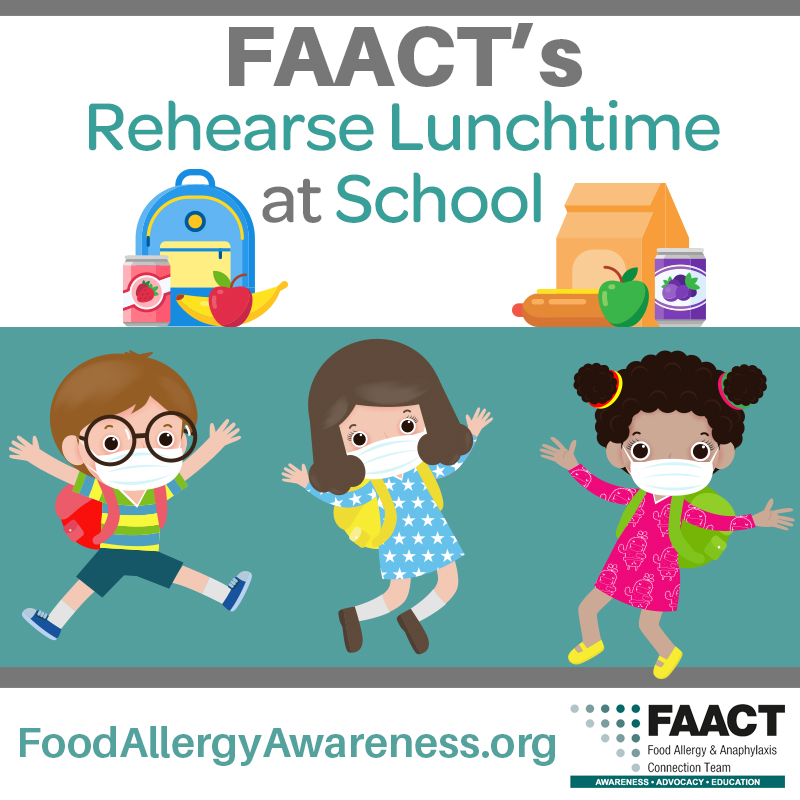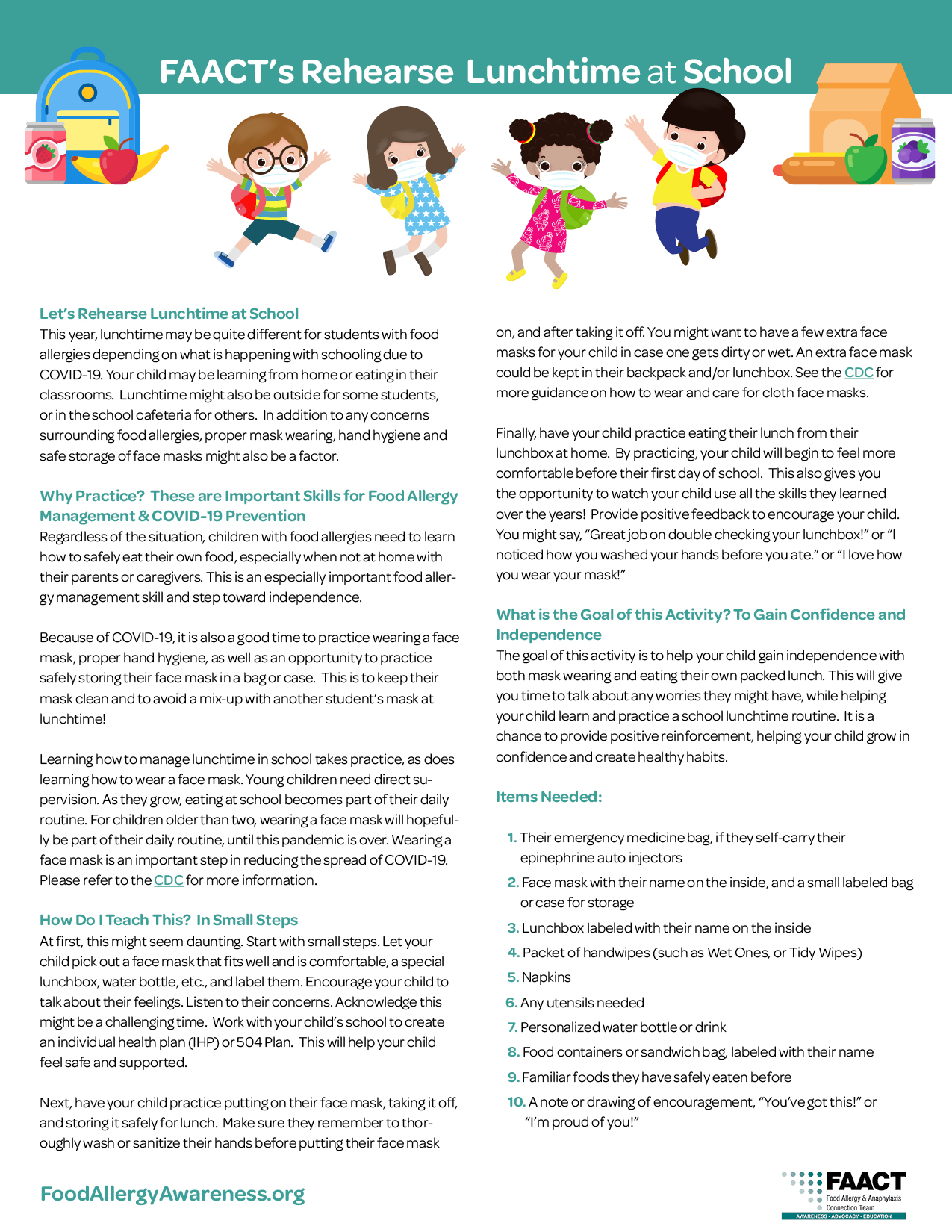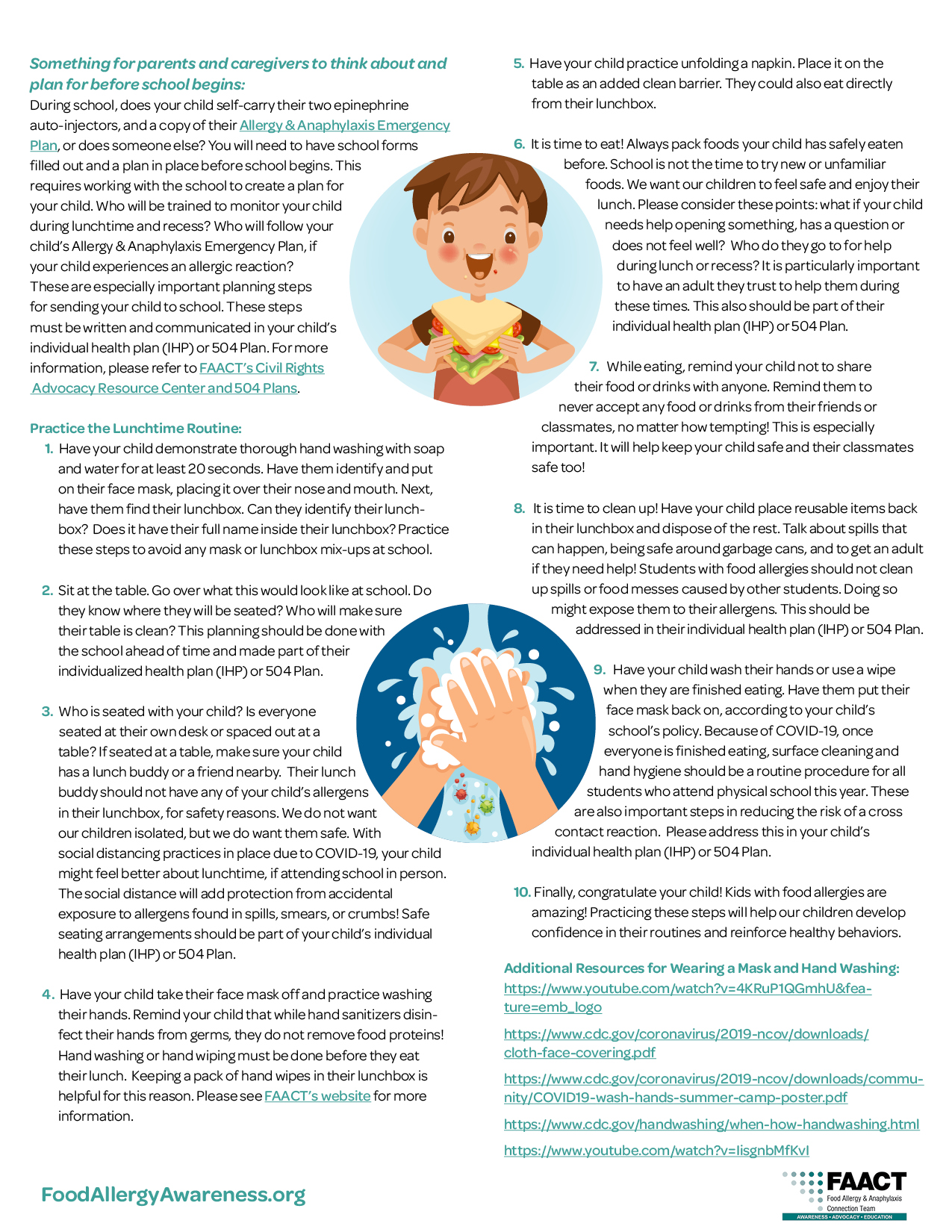Education
Family Activities at Home
Back to Category View
Let’s Rehearse Lunchtime at School
This year, lunchtime may be quite different for students with food allergies depending on what is happening with schooling due to COVID-19. Your child may be learning from home or eating in their classrooms. Lunchtime might also be outside for some students, or in the school cafeteria for others. In addition to any concerns surrounding food allergies, proper mask wearing, hand hygiene and safe storage of face masks might also be a factor.
Why Practice? These are Important Skills for Food Allergy Management & COVID-19 Prevention.
Regardless of the situation, children with food allergies need to learn how to safely eat their own food, especially when not at home with their parents or caregivers. This is an especially important food allergy management skill and step toward independence.
Because of COVID-19, it is also a good time to practice wearing a face mask, proper hand hygiene, as well as an opportunity to practice safely storing their face mask in a bag or case. This is to keep their mask clean and to avoid a mix-up with another student’s mask at lunchtime!
Learning how to manage lunchtime in school takes practice, as does learning how to wear a face mask. Young children need direct supervision. As they grow, eating at school becomes part of their daily routine. For children older than two, wearing a face mask will hopefully be part of their daily routine, until this pandemic is over. Wearing a face mask is an important step in reducing the spread of COVID-19. Please refer to the CDC for more information.
How Do I Teach This? In Small Steps.
At first, this might seem daunting. Start with small steps. Let your child pick out a face mask they like, a special lunchbox, water bottle, etc., and label them. Encourage your child to talk about their feelings. Listen to their concerns. Acknowledge this might be a challenging time. Work with your child’s school to create an individual health plan (IHP) or 504 Plan. This will help your child feel safe and supported.
Next, have your child practice putting on their face mask, taking it off, and storing it safely for lunch. Make sure they remember to thoroughly wash or sanitize their hands before putting their face mask on, and after taking it off. You might want to have a few extra face masks for your child in case one gets dirty or wet. An extra face mask could be kept in their backpack and/or lunchbox. See the CDC for more guidance on how to wear and care for cloth face masks.
Finally, have your child practice eating their lunch from their lunchbox at home. By practicing, your child will begin to feel more comfortable before their first day of school. This also gives you the opportunity to watch your child use all the skills they learned over the years! Provide positive feedback to encourage your child. You might say, “Great job on double checking your lunchbox!” or “I noticed how you washed your hands before you ate.” or “I love how you wear your mask!”
What is the Goal of this Activity? To Gain Confidence and Independence.
The goal of this activity is to help your child gain independence with both mask wearing and eating their own packed lunch. This will give you time to talk about any worries they might have, while helping your child learn and practice a school lunchtime routine. It is a chance to provide positive reinforcement, helping your child grow in confidence and create healthy habits.
Items Needed:
- Their emergency medicine bag, if they self-carry their epinephrine auto injectors.
- Face mask with their name on the inside, and a small labeled bag or case for storage
- Lunchbox labeled with their name on the inside
- Packet of handwipes (such as Wet Ones, or Tidy Wipes)
- Napkins
- Any utensils needed
- Personalized water bottle or drink
- Food containers or sandwich bag, labeled with their name
- Familiar foods they have safely eaten before
- A note or drawing of encouragement, “You’ve got this!” or “I’m proud of you!”
Something for parents and caregivers to think about and plan for before school begins:
During school, does your child self-carry their two epinephrine auto-injectors, and a copy of their Allergy & Anaphylaxis Emergency Plan, or does someone else? You will need to have school forms filled out and a plan in place before school begins. This requires working with the school to create a plan for your child. Who will be trained to monitor your child during lunchtime and recess? Who will follow your child’s Allergy & Anaphylaxis Emergency Plan, if your child experiences an allergic reaction? These are especially important planning steps for sending your child to school. These steps must be written and communicated in your child’s individual health plan (IHP) or 504 Plan. For more information, please refer to FAACT’s Civil Rights Advocacy Resource Center and 504 Plans.
Practice the Lunchtime Routine:
- Have your child demonstrate thorough hand washing with soap and water for at least 20 seconds. Have them identify and put on their face mask, placing it over their nose and mouth. Next, have them find their lunchbox. Can they identify their lunchbox? Does it have their full name inside their lunchbox? Practice these steps to avoid any mask or lunchbox mix-ups at school.
- Sit at the table. Go over what this would look like at school. Do they know where they will be seated? Who will make sure their table is clean? This planning should be done with the school ahead of time and made part of their individualized health plan or 504 Plan.
- Who is seated with your child? Is everyone seated at their own desk or spaced out at a table? If seated at a table, make sure your child has a lunch buddy or a friend nearby. Their lunch buddy should not have any of your child’s allergens in their lunchbox, for safety reasons. We do not want our children isolated, but we do want them safe. With social distancing practices in place due to COVID-19, your child might feel better about lunchtime, if attending school in person. The social distance will add protection from accidental exposure to allergens found in spills, smears, or crumbs! Safe seating arrangements should be part of your child’s individual health plan (IHP) or 504 Plan.
- Have your child take their face mask off and practice washing their hands. Remind your child that while hand sanitizers disinfect their hands from germs, they do not remove food proteins! Hand washing or hand wiping must be done before they eat their lunch. Keeping a pack of hand wipes in their lunchbox is helpful for this reason. Please see FAACT’s website for more information.
- Have your child practice unfolding a napkin. Place it on the table as an added clean barrier. They could also eat directly from their opened lunchbox.
- It is time to eat! Always pack foods your child has safely eaten before. School is not the time to try new or unfamiliar foods. We want our children to feel safe and enjoy their lunch. Please consider these points: what if your child needs help opening something, has a question or does not feel well? Who do they go to for help during lunch or recess? It is particularly important to have an adult they trust to help them during these times. This also should be part of their individual health plan (IHP) or 504 Plan.
- While eating, remind your child not to share their food or drinks with anyone. Remind them to never accept any food or drinks from their friends or classmates, no matter how tempting! This is especially important. It will help keep your child safe and their classmates safe too!
- It is time to clean up! Have your child place reusable items back in their lunchbox and dispose of the rest. Talk about spills that can happen, being safe around garbage cans, and to get an adult if they need help! Students with food allergies should not clean up spills or food messes caused by other students. Doing so might expose them to their allergens. This should be addressed in their individual health plan (IHP) or 504 Plan.
- Have your child wash their hands or use a wipe when they are finished eating. Have them put their face mask back on, according to your child’s school’s policy. Because of COVID-19, once everyone is finished eating, surface cleaning and hand hygiene should be a routine procedure for all students who attend physical school this year. These are also important steps in reducing the risk of a cross contact reaction. Please address this in your child’s individual health plan (IHP) or 504 Plan.
- Finally, congratulate your child! Kids with food allergies are amazing! Practicing these steps will help our children develop confidence in their routines and reinforce healthy behaviors.
Additional Resources for Wearing a Mask and Hand Washing:
- Cincinnati Children\'s: Masked Heroes (YouTube)
- Johns Hopkins Medicine: Hand-washing Steps Using the WHO Technique (YouTube)
- CDC: How to Safely Wear and Take Off a Cloth Face Covering
- CDC: When & How to Wash Your Hands
- CDC: Campers: Do Your Part to Stop COVID-19 in its Tracks. Did You Wash Your Hands?
Download FAACT's Let's Rehearse Lunchtime at School activity.

